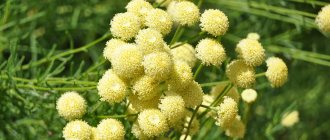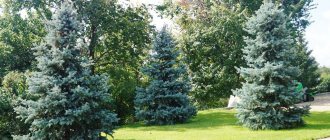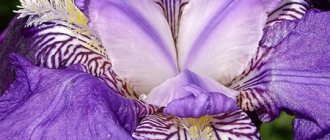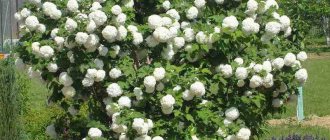- October 28, 2019
- Flowers
- Ekaterina Komisarova
Today there are a huge number of cultures in the world. Some are used for landscape design, others feel comfortable in an apartment. The most important thing is to provide all plants with proper care, otherwise they may die.
Astilbe is a perennial crop belonging to the Saxifraga family, which unites about 40 species and more than 400 varieties. Among gardeners, it is more commonly known as “false spirea.” The flower has excellent decorative qualities, as well as long and abundant flowering. In addition, the plant adapts well to any climatic conditions, can grow in partial shade and survive in soils with high humidity. However, despite the unpretentiousness of the flower, when breeding it it is necessary to take into account some nuances, without which it will not be healthy and attractive. Let's find out how to grow astilbe at home. This article will not only discuss the basic subtleties of the content, but also tell you several tricks that will make care as effective as possible with little physical effort.
general information
The historical homeland of astilbe (planting and caring for the plant will be described in detail in this article) is Japan, East Asia and North America. The height of the bush can vary from 15 cm to two meters, depending on the specific variety and conditions of maintenance. During the active growing season, flowers appear on the shoots, the colors of which can be very different: white, dark orange, red, lilac, pink and burgundy.
The leaves have a complex pinnate shape, are large in size and have a dark green color, making the bushes very lush and beautiful. During the flowering period of astilbe, which lasts from June to August, seed boxes appear in place of the buds. When they are ripe, they are collected, dried and used for propagation. The planting material is of high quality and has a high germination percentage, and also retains the characteristics of the mother plant, so there is little point in buying it in stores.
The culture is classified as frost-resistant and can adapt to almost any climatic conditions. With proper insulation, it can withstand even forty-degree frosts. That is why many gardeners grow astilbe in open ground. However, in this case it is necessary to take the choice of planting substrate very seriously. The most preferable are nutritious soils with good moisture permeability.
How to plant astilbe in spring
Astilbe is planted in open ground in the spring. This can be done from March to May. Tall astilbes are planted at a distance of 50 cm, low ones - up to 30 cm from each other. If you are transplanting astilbe in the spring or planting cuttings, dig up the area in advance (preferably in the fall) and add compost, decomposed peat and rotted manure (at the rate of 2 buckets per 1 sq.m.).
When planting astilbe in the spring, dig a small hole (20-30 cm deep), pour in 30 g of granular complex fertilizer, 1/2 cup of ash, add humus, mix thoroughly and water generously. Plant a seedling in moist soil and mulch it with bark, straw, pebbles or sawdust (the mulch layer should be 3-5 cm).
Mulch will help retain moisture in the soil and create comfortable conditions for wintering astilbe
Most common types
As noted earlier, about 40 varieties of the crop and more than 400 different varieties are known. But astilbes are not so widely used in landscape design. The following types have become popular among gardeners:
- Astilbe davidii. A shrub growing up to one and a half meters in height. A characteristic feature is a lush crown and leaves of a unique shape. The color of astilbe of this variety can be pink or lilac. Flowering occurs at the end of summer and continues until mid-autumn.
- Astilbe glaberrima. An ornamental plant whose height does not exceed 12 centimeters. The crown is very lush, can reach a diameter of 15 cm, subject to the watering regime and regular feeding. The leaves are dark orange with a bronze tint, giving the shrub an incredibly attractive appearance.
- Astilbe chinensis. This plant is also called Astilbe rosea. The leaves are quite large with a glossy surface and small hairs. The buds are small, collected in inflorescences reaching a length of 30 centimeters. They can be pink, white and lilac. Blooms almost throughout the summer.
- Astilbe japonica. The plant is 70 centimeters high and has a very lush crown. The leaves have a pinnate shape, large size and glossy texture. Flowers are white and pink. They are collected in long inflorescences and during the active growing season they exude an amazing aroma.
- Astilbe thunbergii. These are tall growing shrubs, reaching a height of 80 centimeters. The leaves of this species of astilbe have a complex shape and pointed edges. White buds form inflorescences 25 centimeters long and 10 centimeters wide.
The most popular is pink astilbe. It is particularly decorative and unpretentious, which is why many gardeners around the world use it to decorate their garden plots. However, it is worth noting that this and the other varieties described above belong to the same species - Arendsa. Therefore, the features of keeping them at home are practically no different.
Types and varieties
There are different types of astilbe:
- dwarf (astilbe variety “Lilliput”) - no more than 30 cm in height;
- low - up to 60 cm;
- medium tall - approximately 90 cm;
- tall (David's astilbe) - reach 1.2-2 m.
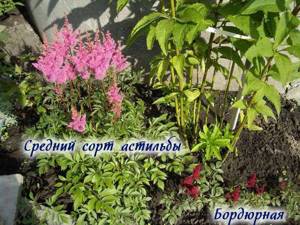
Astilbe arendsa amethyst - the variety reaches 1.5 m in length. Flowering is long, shades vary from white to burgundy. The plant is the most unpretentious of all its fellows.
Chinese astilbe - the height of the inflorescences reaches 40 cm. There are shades of red, white and pink. The variety is unpretentious in care. Can grow in both sunny and semi-shaded places.
Astilbe Chinese variety pumila is particularly frost-resistant. Plant up to 40 centimeters tall. The leaves are compound, shiny, covered with red hairs on both sides. The flowers are small, lilac-pink, collected spectacularly in panicles up to 30 cm long.
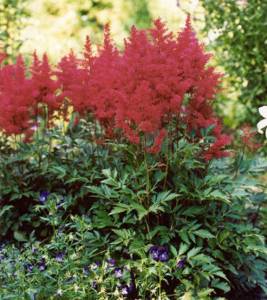
Astilbe Japanese Montgomery reaches a height of up to 80 cm. It prefers moist soil, so it can be an excellent addition to a reservoir.
The leaves are double pinnate, dark green on red petioles, decorating the bush before and after flowering. Flowers with a pleasant aroma are collected in dense, rhombic panicles.
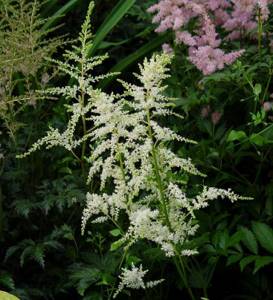
Astilbe japonica, Deutschland variety, is a mid-early variety, plant height 50 cm.
It has dark green smooth leaves and white flowers collected in neat diamond-shaped panicles. Blooms from May to July. Frost-resistant.
Astilbe Weiss Gloria - belongs to the pyramidal variety. The shrub is spreading, with dense foliage. The plant is tall and suitable for decorating ponds.
Cultivation
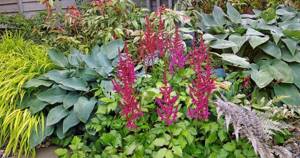
According to many gardeners, there are no special problems with astilbe. Planting and care are very simple, since the plant is unpretentious. However, when growing green crops, special attention should be paid to the quality of planting material. Based on what experts say, you can achieve 100 percent germination if you take into account certain requirements for the root system when planting. There should be no damaged or dead shoots, as well as rotten shoots. Before planting, carefully inspect all roots and make sure they are straight.
If you do not take these features into account, this does not mean that the plant will not be able to take root. There are chances for good growth and development, but they are relatively low. In addition, there is a high probability that the flowers will be sick for a long time, which will negatively affect their decorative effect.
Preparing for winter
Proper care and planting help to grow astilbe in open ground, which will easily survive the winter months, and with the onset of warm weather will delight you with good growth and abundant flowering.
From late autumn until frost, the plant is pruned above ground. It is cold-resistant, so it requires virtually no care.
To protect her from low temperatures, a snow shelter will suffice. If there is little rainfall in winter, then the perennial is insulated with spruce branches - this must be done so as not to worry in the spring why the crown of astilbe is not renewed.
Choosing a place for a plant
Maintaining astilbe (planting and care does not cause any special problems even for beginners) will be much easier if you choose a suitable place for it in the garden. The culture thrives in partial shade, but exposure to direct sunlight is detrimental to it. It is not recommended to plant shrubs in open, unprotected areas. In addition, plants are sensitive to excessive soil moisture, so it is better to choose places for them where there is no groundwater near the surface. Otherwise, astilbe may develop problems with the health of the root system, which can lead to its death.
If there are underground reservoirs on your land, then a prerequisite is the presence of a good drainage system. A variety of materials can be used, but expanded clay is best suited for these purposes.
Care
Astilbe grown in the garden presents its owner with the main desire - keeping the soil moist.
Drying out is dangerous for the plant.
Fertilizing begins in early spring, introducing nitrogen fertilizers, potassium fertilizers in July, and phosphorus fertilizers at the end of flowering.
After each feeding, the soil must be loosened and then mulched. This will help retain moisture and protect the plant from weeds and direct sunlight.
The crop does not need pruning during flowering, as it forms a crown on its own. Dried leaves, stems and inflorescences should be removed periodically.
Landing rules
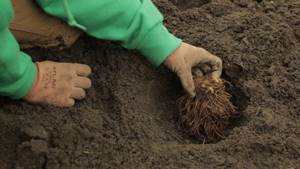
This is a very important aspect that most beginners often do not pay enough attention to. When to plant astilbe? The optimal period is considered to be the beginning of spring. Despite its rapid growth, the plant requires time for good rooting, acclimatization and preparation for the upcoming winter. Having decided on the most suitable place for planting, you can begin preparing the planting hole. Its depth is determined individually for each flower, depending on the size of the root system. She should fit comfortably in the hole and not feel constrained. In this case, the bush should not be placed too deep in the ground, as this will negatively affect its development. To stimulate the growth of astilbe, the bottom of the hole can be sprinkled with a special mixture. To prepare it, you need to mix one matchbox of wood ash, bone meal and complex mineral fertilizers.
After the flower is placed and the hole is filled, the surface of the soil should be sprinkled with a not too thick layer of bark or peat. Mulching will prevent moisture from evaporating too quickly, which will reduce the intensity of watering.
Transplantation and formation of a bush
Astilbe is a perennial plant, but periodically needs replanting. Branched rhizomes grow “up” and begin to protrude from the ground; in this case, the annual “growth” can reach 5 cm. The roots that are on the surface dry out and overheat. They are sprinkled with soil annually, and every 4-5 years they are replanted and buried.
Astilbe tolerates transplantation well. In the process, you don’t even have to change its location - the bush is simply removed from the ground, the hole is deepened, and planted so that the entire rhizome is underground. The most suitable time for the procedure is mid-spring.
Astilbe bushes can have a spherical or pyramidal shape, depending on the variety. They do not need additional pruning; young shoots that appear in the spring branch on their own and form a lush crown. It is enough to promptly remove dried leaves and stems.
Features of care
Above we described in detail how and when to plant astilbe. Now let's look at the features of proper care. This type of perennial herbaceous plant is unpretentious and has strong immunity, so there are no special problems when maintaining it. Every year the bushes add 3-5 centimeters in height. The main care measures concern the root system. Once a year, a little fertile soil is poured into the hole.
The plant is also moisture-loving, so it is necessary to adhere to a certain watering regime. But they shouldn't be too plentiful. It will be enough just to keep the soil moist. To simplify the task, you can carry out mulching, which will slow down the evaporation of moisture. In addition, this procedure will protect the astilbe from severe frosts in winter.
Pruning bushes is not always possible, however, it will give them a more attractive appearance. A mandatory procedure is to remove faded buds. This is especially true if the plant is bred for decorative purposes.
Caring for astilbe in open ground
Growing astilbe is a simple process; this plant has perfectly adapted to local climatic conditions and, if you choose the right place, will not cause any trouble. The key to success is strict adherence to several rules of agricultural technology.
Watering and fertilizing
An important aspect of astilbe care is watering. It should be regular and plentiful. Only Chinese astilbe will calmly tolerate a slight overdrying of the soil; other varieties will respond by dropping leaves and flowers. Astilbe “drinks” especially a lot during the budding period, at the beginning of summer - in dry weather it is watered twice a day. At the same time, she does not like moisture on the leaves.
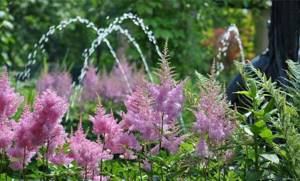
Adult astilbe bushes are fed twice a year. In the spring, nitrogen-potassium fertilizers are applied to promote more intense vegetation. At the beginning of summer, when astilbe blooms, it is fertilized with phosphorus-potassium mixtures.
Loosening and mulching
After watering, when the soil dries out a little, it is loosened. This procedure helps retain moisture. When loosening, weeds are removed so that they do not “take away” water and nutrients. Do not use sharp tools and act carefully so as not to damage the root system.
One of the important points in caring for astilbe is mulching. The mound is made high, up to 3 cm, using straw, sawdust, husks and other suitable materials. The shelter is regularly updated. Mulch not only helps retain moisture, but also protects the roots from overheating.
Preparing astilbe for winter
After the bushes have flowered, the panicles are left, since even when dried they retain their decorative properties. Caring for astilbe in the fall comes down to regular watering. When the flower stalks fall off, they are cut off, and in mid-October the astilbe shoots are cut off completely.
Astilbe tolerates frost well, but preparation for winter is still needed. The rhizomes are covered with straw or fallen leaves. Bushes planted in autumn are additionally covered with branches. The shelter is removed late, at the beginning of May, since astilbe does not tolerate temperature changes typical of early spring.
Feeding
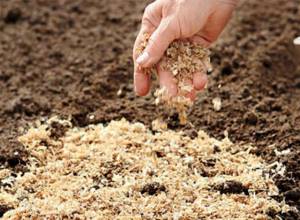
If you use astilbe (the planting and care of which were described in detail earlier) in landscape design, then it is very important that the plant not only grows well, but also looks attractive. To do this, you need to periodically add fertilizer to the soil to provide the shrubs with all the necessary nutrients. To do this, it is better to use complex mineral mixtures intended for caring for garden plants. Thanks to them, the shrubs will grow well without rejuvenation and replanting for at least five years.
In order for the crown to remain lush, fertilizing with nitrogen-containing fertilizers is periodically required. They stimulate foliage growth and will allow astilbe to recover faster after hibernation. During the active growing season, plants need phosphorus, so they use products that contain large amounts of this element. It has a positive effect on the abundance and duration of flowering, so you can enjoy the beauty of flowers much longer.
What plants does it go with?
Real gardeners know that each plant has its own “favorites”: those neighbors next to whom it feels and blooms best. Astilbe is no exception.
This perennial beauty, thanks to its decorative and picturesque appearance, perfectly sets off the monochrome greenery of coniferous specimens. And the neighbors provide the astilbe with much-needed shade.
Astilbe also looks great next to irises (you can see what the Dutch Iris looks like in the photo in this article), Dutch tulips (but when to plant tulips in open ground, you can learn from this article) periwinkle (and here’s how to care for and grow such colors, indicated in great detail in this article). Even a single plant planted on a simple lawn surprises with its decorative effect. But how good ornamental cabbage will look and how to plant it is described in this article.
Astilbe is highly valued by landscape designers, as it is one of the most picturesque botanical specimens suitable for shady plantings - group and single.
We looked at the features of growing and caring for astilbe, an ornamental plant used in landscape design. As you can see, there is nothing particularly difficult about growing this representative of the flora. By following the simple recommendations given in the article, you can correctly plant astilbe in open ground and provide it with proper care after rooting. In return, the plant will delight you with wonderful flowering and will become a real pearl of your garden.
Reproduction

This question interests many novice flower growers. You can grow the plant both in an apartment and in a garden. Astilbe will grow equally well under any conditions. There are also no special problems with reproduction. You can do it in one of the following ways:
- seed;
- dividing the bush;
- kidney division.
Each of them is highly effective, but has certain characteristics. According to experts, seed technology is considered the best. It allows you to preserve the characteristics of the mother plant as much as possible. But in order for the shrubs to meet all varietal characteristics, it is necessary to use only high-quality planting material.
Sowing of seeds is carried out on pre-moistened soil. There is no need to deepen them. To speed up the germination process, the substrate is irrigated daily with a spray bottle. Watering is especially important in the case of young seedlings. Their untimely implementation can lead to the death of plants.
To increase the percentage of germination and strengthen immunity, it is recommended to stratify the seeds. To do this, they are placed for 20 days in a place protected from sunlight, in which the air temperature is constantly kept between -4 and +4 degrees. After this, they are sown in a greenhouse. The first shoots, as a rule, appear after 1-2 weeks, and they can be replanted in open ground after 2-3 months.
How does it reproduce
The plant has several methods of reproduction. Let's take a closer look at them.
By division
This is the most proven and familiar method of plant propagation. To implement this method, you must carefully dig up the mother plant, being careful not to damage its roots. To carefully remove the rhizome, the ground around it needs to be excavated with approximately a radius of 15-20 cm. After digging with a knife, you need to divide the root into 2-3 parts: it is important that there are buds on each separated part. After dividing, sprinkle the fresh sections with crushed charcoal.
Place the divided rhizomes into the furrow prepared for this, and immediately water the soil on top. Rooting stimulants added to the water will help the plant take root faster and grow into an independent specimen.
When the young shoots hatch, you must remember to water them, and you also need to loosen the soil to ensure oxygen access to the roots. You can plant shoots in open ground in the spring, as early as March. And for the first time, astilbe will bloom with this method of propagation in the fall.
On video how Astilbe reproduces:
Kidneys
This method is considered the fastest. To implement it, it is necessary in the spring to separate several buds from the mother plant along with parts of the rhizomes. Then you need to plant the separated shoots in a sheltered, warm place (greenhouse). The soil should include a mixture of sand and gravel and be sufficiently moist.
This method gives a high percentage of survival of the “young animals”. However, for astilbe to begin to bloom with this propagation method, you need to wait almost a year.
Seeds
The method of propagating Astilbe from seeds at home is also very common, and gives very good results. For propagation, healthy, ripe seeds are used: they are taken from the capsules that appear on the site of astilbe flowers.
Seeds are planted in the soil in March, having previously been stratified. They are sown in special containers with a moistened peat-sand mixture. A layer of snow is placed on top of the ground, which can also be taken from the freezer. After the snow has melted, the container with the seeds is covered with film and placed in the refrigerator on the bottom shelf for 20 days. At this time, the first shoots appear. Moreover, the most hardened specimens will survive, which will ensure guaranteed durability and successful development of plants.
After completing 20 days in the refrigerator, the container is moved to light: the air temperature should be about +20 degrees. Sprouts exposed to light must be watered. But this must be done extremely carefully: it is better to use a syringe without a needle, and direct the stream of water carefully under the spine. When 2-3 leaves appear on the sprouts, transplant them into separate containers.
Attention: only varietal specimens can be propagated in this way, since hybrids do not transmit their specific characteristics.
Diseases and pests
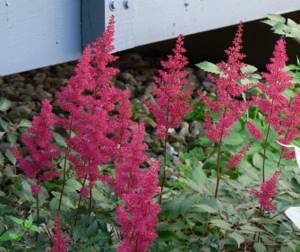
Astilbe is a truly unique plant that is highly resistant to adverse factors and has strong immunity. Plants are practically not susceptible to diseases and attacks from harmful insects. Sometimes when growing some varieties, the root system of shrubs can be affected by roundworms. The main problem in controlling these pests is that they do not respond to any chemicals. The only way out is to dig up and burn the plant. To prevent their occurrence in the future, part of the soil must also be removed. It will be possible to plant new flowers on this piece of land only after 2-3 years.
Propagation by dividing rhizomes
This is the most effective reproduction option, which is used more often than others:
- Remove the bush from the soil by tearing it out, capturing 15–20 cm of the area in a circle.
- Then they are pulled out and shaken until the roots are significantly exposed.
- Then cut out a cutting with a piece of root so that there are at least 4 buds on it.
- Dried rhizomes are removed.
- A distance of 30 cm is maintained between planted perennials.
Within six months the plant will bloom.
